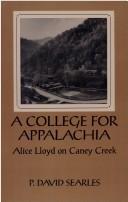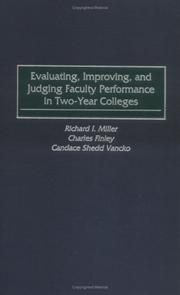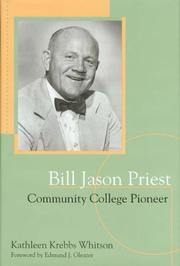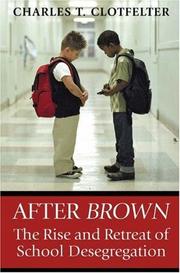| Listing 1 - 10 of 10 |
Sort by
|

ISBN: 0813159032 9780813159034 1322596468 9781322596464 0813118832 9780813118833 Year: 2015 Publisher: Lexington The University Press of Kentucky
Abstract | Keywords | Export | Availability | Bookmark
 Loading...
Loading...Choose an application
- Reference Manager
- EndNote
- RefWorks (Direct export to RefWorks)
Alice Spencer Geddes Lloyd was a New England woman with a mission in life. In 1916 she settled on Caney Creek in Eastern Kentucky, determined to bring higher education to this remote corner of Appalachia. The school she founded, now Alice Lloyd College, continues to serve the area and its people and to stand as a tribute to Lloyd's remarkable energy, determination, and vision.Lloyd's program combined a rigorous academic curriculum with an intense effort to instill a sense of service in the school's graduates. This education was provided free and required only that the students abide by Lloyd's
Educators --- Biography. --- Lloyd, Alice, --- Lloyd, Alice Spencer Geddes, --- Alice Lloyd College --- Caney Junior College --- Lloyd College --- Lloyd (Alice) College --- Alice Lloyd Junior College --- History. --- Appalachian Region
Book
ISBN: 1350145335 1350145327 1350145343 9781350145320 9781350145337 9781350145344 9781350145313 9781350212190 Year: 2020 Publisher: London [England] : [London, England] : Bloomsbury Academic, Bloomsbury Publishing,
Abstract | Keywords | Export | Availability | Bookmark
 Loading...
Loading...Choose an application
- Reference Manager
- EndNote
- RefWorks (Direct export to RefWorks)
"The book explores the story of students studying undergraduate degrees at colleges that offer degree courses but which do not have university status. Henderson considers how relationships to these places affect educational experience, how decisions are made about whether to leave or to stay for degree study, and what it means to be an undergraduate student who does not attend a university. As well as working against the assumptions made about the lives and characteristics of a surprisingly diverse and complex group of students, the book offers insights into the ways that place and space are crucial factors for anyone thinking about systemic and structural inequality in higher education"--
Postsecondary education --- Junior colleges --- Junior college students --- College student mobility --- Educational equalization --- Regional disparities.

ISBN: 0313001294 9780313001291 0897896920 9780897896924 1280913541 9786610913541 9798400648229 9781280913549 Year: 2000 Publisher: Westport, Conn. : London : Praeger, Bloomsbury Publishing,
Abstract | Keywords | Export | Availability | Bookmark
 Loading...
Loading...Choose an application
- Reference Manager
- EndNote
- RefWorks (Direct export to RefWorks)
This manual provides practical material for faculty evaluation and professional development within two-year college systems. It is designed to help teachers who would like professional development and improvement, as well as human resource managers and staff development officers.
Community college teachers --- Municipal junior college teachers --- College teachers --- Community colleges --- Rating of --- In-service training --- Faculty

ISBN: 1574414186 1433710056 1417593571 9781417593576 9781433710056 9781574411744 1574411748 9781574414189 Year: 2004 Publisher: Denton, TX University of North Texas Press
Abstract | Keywords | Export | Availability | Bookmark
 Loading...
Loading...Choose an application
- Reference Manager
- EndNote
- RefWorks (Direct export to RefWorks)
Bill Jason Priest is credited with developing and defining the Dallas County Community College District.Drawing from archives and numerous interviews with Priest and his personal and professional associates, this text presents the life of this notable figure in Texas education.
Book
ISBN: 0674053664 9780674053663 0674035488 9780674035485 Year: 2009 Publisher: Cambridge, Mass. : Harvard University Press,
Abstract | Keywords | Export | Availability | Bookmark
 Loading...
Loading...Choose an application
- Reference Manager
- EndNote
- RefWorks (Direct export to RefWorks)
Rebecca D. Cox draws on five years of interviews and observations at community colleges, where she shows how students and their instructors misunderstand and ultimately fail one another, despite good intentions. Eye-opening even for experienced faculty and administrators, The College Fear Factor reveals how the traditional college culture can actually pose obstacles to students' success, and suggests strategies for effectively explaining academic expectations.
Community college students --- Community college teachers --- Teacher-student relationships. --- Communication in education. --- Educational psychology. --- Education --- Psychology --- Pupil-teacher relationships --- Student and teacher --- Student-teacher relationships --- Students and teachers --- Teacher and student --- Teacher-pupil relationships --- Teachers and students --- Interpersonal relations --- Municipal junior college teachers --- College teachers --- Community colleges --- Junior college students --- Psychology. --- Attitudes. --- Faculty
Book
ISBN: 1435690400 9781435690400 2763750451 9782763750453 Year: 2008 Publisher: Qu_bec City : Les Presses de l'Université Laval,
Abstract | Keywords | Export | Availability | Bookmark
 Loading...
Loading...Choose an application
- Reference Manager
- EndNote
- RefWorks (Direct export to RefWorks)
Cegeps. --- Jeunesse --- Succes scolaire --- Étudiants du collegial --- Junior college students --- CEGEPs (Educational institutions) --- Attitudes. --- Moeurs et coutumes. --- Travail. --- Reseaux sociaux. --- Social life and customs. --- Social networks. --- Employment. --- Quebec (Province)
Book
ISBN: 2763738591 9782763738598 Year: 2018 Publisher: [Québec] : Baltimore, Md. : Presses de l'Université Laval, Project MUSE,
Abstract | Keywords | Export | Availability | Bookmark
 Loading...
Loading...Choose an application
- Reference Manager
- EndNote
- RefWorks (Direct export to RefWorks)
"Pour plusieurs, l'éducation devrait être la priorité de la société. Très bien, alors, à l'intérieur du système d'éducation, quel savoir faut-il prioriser ? Comme on le voit dans les milieux de pointe -- en électronique, informatique, robotique, nanotechnologie --, les savoir-faire seront bientôt appris dans les laboratoires des entreprises ou dans des laboratoires universitaires subventionnés en partie par des entreprises privées. Or, la technologie a beau changer, la nécessité d'interpréter le monde ne cesse pas pour autant. Aussi, pour décoder notre environnement mondialisé et être en mesure d'y évoluer avec maturité et confiance, la jeunesse devra, en plus de maîtriser d'autres langues et d'avoir développé une pensée critique, posséder une perspective historique, des grilles d'analyse sociopolitique, des repères interculturels, un certain bagage philosophique, autant de savoirs reflétant une acquisition vaste et profonde de culture générale. Dans cet ouvrage, l'auteur fait état de recherches qui portent sur le rehaussement de la culture générale des jeunes lors de leur passage au cégep. C'est durant cette période qu'ils atteignent une maturation intellectuelle qui favoriserait à la fois l'approfondissement de leur culture générale et l'intégration de sa fonction critique dans leur vie. "--Résumé de l'éditeur.
Autodidaxie --- Étudiants du collégial --- Formation générale --- Enseignement collégial --- General education --- Junior college students. --- CEGEPs (Educational institutions) --- Education, Higher --- Attitudes. --- Finalités --- Aims and objectives --- Quebec. --- Québec.
Book
ISBN: 0773429697 9780773429697 9780773430433 0773430431 Year: 2012 Publisher: Lewiston Edwin Mellen Press
Abstract | Keywords | Export | Availability | Bookmark
 Loading...
Loading...Choose an application
- Reference Manager
- EndNote
- RefWorks (Direct export to RefWorks)
A careful analysis compiled from six case studies of factors that impede educational success among Hispanic high school graduates going on to college.For the first time in this collected volume of six case studies, scholars will be able to find out the subjective reasons why Hispanic students drop out of college at a higher rate than any other racial or ethnic group. Filled with qualitative and quantitative analysis, this text provides evidence and gives a brief, but narrow entranceway into the lives of Hispanic college students. Whether or not community college is the right path to take for s
Community college students -- United States. --- Hispanic American college students. --- Students, Transfer of -- United States. --- Hispanic American college students --- Students, Transfer of --- Community college students --- Education --- Social Sciences --- Education, Special Topics --- Junior college students --- Transfer of students --- School management and organization --- Students --- Universities and colleges --- College students, Hispanic American --- Hispanic American university students --- College students --- Administration
Book
ISBN: 1579225314 9781579225315 9781579224516 1579224512 9781579224523 1579224520 1003444970 1000975428 1000980782 Year: 2010 Publisher: Sterling, Va. Stylus Pub.
Abstract | Keywords | Export | Availability | Bookmark
 Loading...
Loading...Choose an application
- Reference Manager
- EndNote
- RefWorks (Direct export to RefWorks)
Community colleges hold immense promise if they can overcome their historical legacy and be re-institutionalized with unified missions, clear goals of educational success, and adequate financial resources. This book presents the history in all its complexity so that policy makers and practitioners might better understand the constraints of the past in an effort to realize the possibilities of the future.
Community colleges --- Community college students --- College students --- College life --- Universities and colleges --- University students --- Students --- Junior college students --- Community junior colleges --- Local junior colleges --- Municipal junior colleges --- Public community colleges --- Public junior colleges --- Public two-year colleges --- Two-year colleges --- Junior colleges --- Public universities and colleges --- History. --- Conduct of life --- Education

ISBN: 9786613291066 1283291061 140084133X 9781400841332 0691119112 9780691126371 9780691119113 0691126372 9781283291064 Year: 2004 Publisher: Princeton, N.J. : Princeton University Press,
Abstract | Keywords | Export | Availability | Bookmark
 Loading...
Loading...Choose an application
- Reference Manager
- EndNote
- RefWorks (Direct export to RefWorks)
The United States Supreme Court's 1954 landmark decision, Brown v. Board of Education, set into motion a process of desegregation that would eventually transform American public schools. This book provides a comprehensive and up-to-date assessment of how Brown's most visible effect--contact between students of different racial groups--has changed over the fifty years since the decision. Using both published and unpublished data on school enrollments from across the country, Charles Clotfelter uses measures of interracial contact, racial isolation, and segregation to chronicle the changes. He goes beyond previous studies by drawing on heretofore unanalyzed enrollment data covering the first decade after Brown, calculating segregation for metropolitan areas rather than just school districts, accounting for private schools, presenting recent information on segregation within schools, and measuring segregation in college enrollment. Two main conclusions emerge. First, interracial contact in American schools and colleges increased markedly over the period, with the most dramatic changes occurring in the previously segregated South. Second, despite this change, four main factors prevented even larger increases: white reluctance to accept racially mixed schools, the multiplicity of options for avoiding such schools, the willingness of local officials to accommodate the wishes of reluctant whites, and the eventual loss of will on the part of those who had been the strongest protagonists in the push for desegregation. Thus decreases in segregation within districts were partially offset by growing disparities between districts and by selected increases in private school enrollment.
Education and state --- Segregation in education --- School integration --- African Americans --- Education --- Segregation --- Academic achievement. --- Affirmative action. --- African Americans. --- Asian Americans. --- Attendance. --- Black school. --- Border Region. --- Brown v. Board of Education. --- Calculation. --- Catholic school. --- Census tract. --- Central State University. --- Charlotte-Mecklenburg Schools. --- Cheyney University of Pennsylvania. --- Civil Rights Act of 1964. --- Classroom. --- Common Core State Standards Initiative. --- Community college. --- De jure. --- Desegregation busing. --- Desegregation. --- Education. --- Elementary school. --- Equal Education. --- Equal opportunity. --- Ethnic group. --- Extracurricular activity. --- Finding. --- Fort Wayne Community Schools. --- Gary Orfield. --- Gordon Allport. --- Graduate school. --- Gunnar Myrdal. --- Harvard College. --- Harvard University. --- Higher education. --- Historically black colleges and universities. --- Household. --- Income. --- Institution. --- Integrated Postsecondary Education Data System. --- Junior college. --- Kindergarten. --- Lincoln University (Pennsylvania). --- Magnet school. --- Matriculation. --- Metropolitan statistical area. --- Middle school. --- Milliken v. Bradley. --- Minority group. --- Mixed-sex education. --- National Association for the Advancement of Colored People. --- National Association of Independent Schools. --- National Center for Education Statistics. --- New York City Department of Education. --- Ninth grade. --- Of Education. --- Office for Civil Rights. --- Pell Grant. --- Percentage point. --- Percentage. --- Policy debate. --- Private school. --- Private sector. --- Private university. --- Psychologist. --- Public school (United Kingdom). --- Public university. --- Racial "a. --- Racial integration. --- Racial segregation. --- Racism. --- Rates (tax). --- School choice. --- School district. --- School of education. --- Secondary education. --- Secondary school. --- Self-esteem. --- Separate school. --- Slavery. --- Social class. --- Social science. --- Sociology. --- Special education. --- State school. --- Student. --- Students' union. --- Suburb. --- Sweatt v. Painter. --- Teacher. --- Tenth grade. --- Tuition payments. --- Undergraduate education. --- University and college admission. --- University of North Carolina. --- University-preparatory school. --- University. --- White flight. --- Year.
| Listing 1 - 10 of 10 |
Sort by
|

 Search
Search Feedback
Feedback About UniCat
About UniCat  Help
Help News
News